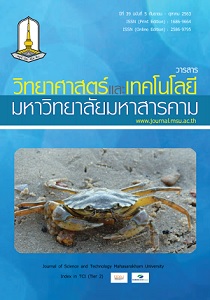Effect of Degree of Roast on Roast Coffee Qualities Using Spouted Bed Roaster
Main Article Content
Abstract
The objective of this research was to study for roasting of coffee bean by spouted bed technique. The roasted coffee bean would be studied on properties and sensory quality tests. The study was conducted by Arabica coffee bean processed by wet process and moisture content at 14.29% dry basis. Coffee bean was roasted at 700 grams in each degree of roasting: city(-), city, full city and Italian and roasting temperature about 255-264 oC until at required coffee bean color. The result found that moisture content of roasted coffee beans are decreased to about 1.05-1.57% dry basis. At higher degree of roasting levels, the coffee beans will burst faster and brightness, red color, yellow color, true density and bulk density will be decreased, whereas, roast loss and organic roast loss will be increased. In addition, the heating time at higher degree of roasting levels will longer than at the soft degree of roasting. For sensory quality tests found that the aroma, clean cup, acidity and flavor will be decreased at higher degree of roasting levels. At degree of roasting level on city: the sweetness, mouth feel, aftertaste and balance will highest and will be decreased at degree of roasting level on full city and Italian, respectively. Moreover, the coffee taste will be the best at degree of roasting level on city.
Article Details
References
2. Wang X, Lim L-T. A Kinetics and modeling study of coffee roasting under isothermal conditions. Food Bioprocess Technology 2014 Jul 28;7: 621-632.
3. Nagaraju VD, Bhattacharya S. Roasting green coffee beans using spouted bed roaster: changes in physical characteristics. J Food Sci Technol 2010 Nov-Dec;47(6): 674-677.
4. โพธิ์ทอง ประณีตพลกรัง และ กิตติ สถาพรประสาธน์. การประยุกต์ใช้เทคนิคสเปาต์เต็ดเบดร่วมกับคลื่นอัล ตร้าซาวด์สำหรับอบแห้งผลผลิตทางการเกษตร. วารสารวิศวกรรมศาสตร์ มหาวิทยาลัยศรีนครินทร วิโรฒ. 2560;12(1): 163-175.
5. Schenker, S. (2000). Investigations on the Hot Air Roasting of Coffee Beans. (Doctoral dissertation), Swiss Federal Institute of Technology, Zurich.
6. AOAC. Official method of analysis: The Association of Official Analytical Chemists. 15th ed. Arlington, VA, USA; 1990.
7. Sweet Maria’s. Using sight to determine degree of roast. Available from: RL: https://legacy.sweet marias.com/library/using-sight-to-determine-degree-of-roast Accessed 2017 Nov 1.
8. บุญคง คำครุฑลาวงษ์, อุษวดี ตันติวรานุรักษ์ และ มารีนา มะหนิ. แบบจำลองการอบแห้งชั้นบางของเมล็ดกาแฟสายพันธุ์คาร์ติมอร์. วารสารวิทยาศาสตร์บูรพา. 2552;14(2): 70-77.
9. สมชาติ โสภณรณฤทธิ์. การอบแห้งเมล็ดพืชและอาหารบางประเภท. พิมพ์ครั้งที่ 7 กรุงเทพ: สถาบันเทคโนโลยีพระจอมเกล้าธนบุรี; 2540.
10. Sweet Maria’s. COE cupping form. Available from: RL: https://legacy.sweetmarias.com/library/coe_ cupping_form/ Accessed 2017 Nov 1.
11. Alonso-Torres B, Hernández-Pérez JA, Sierra-Espinoza F, Schenker S, Yeretzian C. Modeling and validation of heat and mass transfer in individual coffee beans during the coffee roasting process using computational fluid dynamics (CFD). Chimia (Aarau) 2013 March 5; 67(4): 291-294.
12. พีระพงศ์ กัทลี, เชาว์ อินทร์ประสิทธิ์. คุณสมบัติทางกายภาพของเมล็ดกาแฟโรบัสต้า ก่อนคั่วและหลังคั่ว ใน: การประชุมวิชาการแห่งชาติ มหาวิทยาลัย เกษตรศาสตร์ วิทยาเขตกำแพงแสน ครั้งที่ 9. มหาวิทยาลัยเกษตรศาสตร์ วิทยาเขตกำแพงแสน.นครปฐม; 2555. หน้า 97-104.
13. พิมเพ็ญ พรเฉลิมพงศ์ และ นิธิยา รัตนาปนนท์. ปฏิกิริยาเมลลลาร์ด. สืบค้นจาก URL: http://www. foodnetworksolution.com/wiki/word/0397/maillard-reaction. 3 กันยายน 2562.


